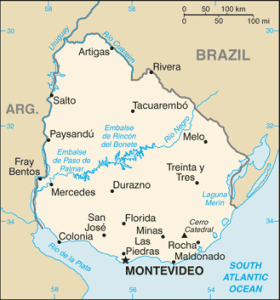Uruguay
Fast Facts
Official Name: Oriental Republic of Uruguay
Form of Government: Constitutional republic
Capital: Montevideo
Population: 3,332,972
Official Language: Spanish
Money: Peso
Area: 68,037 square miles (176,215 sqare kilometers)
What You Should Know
Montevideo, founded by the Spanish in 1726 as a military stronghold, soon took advantage of its natural harbor to become an important commercial center. Claimed by Argentina but annexed by Brazil in 1821, Uruguay declared its independence four years later and secured its freedom in 1828 after a three-year struggle. The administrations of President Jose BATLLE in the early 20th century launched widespread political, social, and economic reforms that established a statist tradition. A violent Marxist urban guerrilla movement named the Tupamaros, launched in the late 1960s, led Uruguay's president to cede control of the government to the military in 1973. By yearend, the rebels had been crushed, but the military continued to expand its hold over the government. Civilian rule was not restored until 1985. In 2004, the left-of-center Frente Amplio Coalition won national elections that effectively ended 170 years of political control previously held by the Colorado and Blanco parties. Uruguay's political and labor conditions are among the freest on the continent.
As with neighboring Argentina, most Uruguayans have ancestors from Spain and Italy who immigrated to the country in the 19th and 20th centuries. The majority of the population is Roman Catholic, though a small community of Jews—one of the largest in South America—lives in the capital of Montevideo.
Red meat is widely consumed in Uruguay, more so than in most other countries. The country's most celebrated festival is Carnival, which takes place just before the start of Lent, a Roman Catholic holiday that traditionally involves abstaining from the consumption of meat. The main festivities take place in Montevideo and include costumes, drumming parades, and outdoor theater.
Soccer is the country's most popular sport; Uruguay is one of the global leaders when it comes to world titles. Basketball, rugby, and boxing also draw large crowds. A popular music and dance in Uruguay is the tango, which originated in Argentina.
Geography
The general character of the land is undulating hills, with a few forest areas along the banks of the numerous streams. Southern Uruguay consists mostly of rolling plains and is an eastward extension of the Argentine pampas. The Atlantic coastline is fringed with tidal lakes and sand dunes. Low, unbroken stretches of level land line the banks of the two border rivers, the Uruguay and the Plata. The northern section is broken by occasional ridges and low ranges (cuchillas), alternating with broad valleys, and is a southern extension of Brazil. The highest point in the country, Catedral, is 514 m (1,686 ft) above sea level. The most noteworthy feature of the northwest landscape is the Cuchilla de Haedo. The Cuchilla Grande runs northeastward from the southern region to the Brazilian border. The Negro, which rises in Brazil, crosses Uruguayan territory and flows into the Uruguay River, which separates Uruguay from Argentina.
Climate
The climate of Uruguay is humid subtropical. It is fairly uniform nationwide, since the country is located entirely within the temperate zone. Seasonal variations are pronounced, but extremes in temperature are rare. As would be expected by its abundance of water, high humidity and fog are common. The absence of mountains and other weather barriers makes all locations vulnerable to high winds and rapid changes in weather as fronts or storms sweep across the country. Seasons are fairly well defined, and in most of Uruguay spring is usually damp, cool, and windy; summers are warm; autumns are mild; and winters are chilly and uncomfortably damp. Northwestern Uruguay, however, is farther from large bodies of water and therefore has warmer summers and milder and drier winters than the rest of the country.




